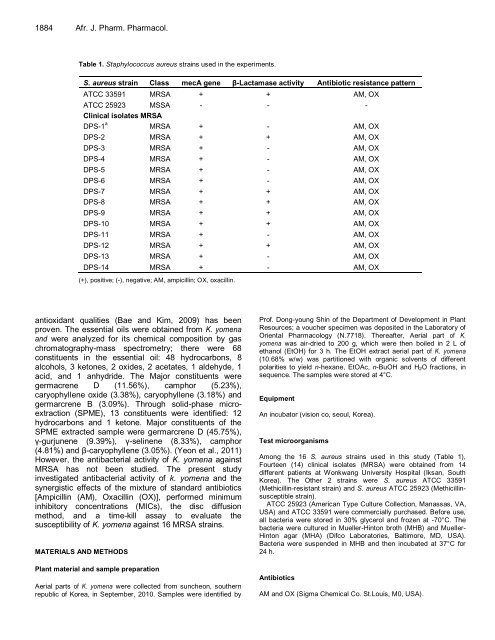Download Complete Issue (pdf 3800kb) - Academic Journals
Download Complete Issue (pdf 3800kb) - Academic Journals
Download Complete Issue (pdf 3800kb) - Academic Journals
Create successful ePaper yourself
Turn your PDF publications into a flip-book with our unique Google optimized e-Paper software.
1884 Afr. J. Pharm. Pharmacol.<br />
Table 1. Staphylococcus aureus strains used in the experiments.<br />
S. aureus strain Class mecA gene β-Lactamase activity Antibiotic resistance pattern<br />
ATCC 33591 MRSA + + AM, OX<br />
ATCC 25923 MSSA - - -<br />
Clinical isolates MRSA<br />
DPS-1 a<br />
MRSA + - AM, OX<br />
DPS-2 MRSA + + AM, OX<br />
DPS-3 MRSA + - AM, OX<br />
DPS-4 MRSA + - AM, OX<br />
DPS-5 MRSA + - AM, OX<br />
DPS-6 MRSA + - AM, OX<br />
DPS-7 MRSA + + AM, OX<br />
DPS-8 MRSA + + AM, OX<br />
DPS-9 MRSA + + AM, OX<br />
DPS-10 MRSA + + AM, OX<br />
DPS-11 MRSA + - AM, OX<br />
DPS-12 MRSA + + AM, OX<br />
DPS-13 MRSA + - AM, OX<br />
DPS-14 MRSA + - AM, OX<br />
(+), positive; (-), negative; AM, ampicillin; OX, oxacillin.<br />
antioxidant qualities (Bae and Kim, 2009) has been<br />
proven. The essential oils were obtained from K. yomena<br />
and were analyzed for its chemical composition by gas<br />
chromatography-mass spectrometry; there were 68<br />
constituents in the essential oil: 48 hydrocarbons, 8<br />
alcohols, 3 ketones, 2 oxides, 2 acetates, 1 aldehyde, 1<br />
acid, and 1 anhydride. The Major constituents were<br />
germacrene D (11.56%), camphor (5.23%),<br />
caryophyllene oxide (3.38%), caryophyllene (3.18%) and<br />
germarcrene B (3.09%). Through solid-phase microextraction<br />
(SPME), 13 constituents were identified: 12<br />
hydrocarbons and 1 ketone. Major constituents of the<br />
SPME extracted sample were germarcrene D (45.75%),<br />
γ-gurjunene (9.39%), γ-selinene (8.33%), camphor<br />
(4.81%) and β-caryophyllene (3.05%). (Yeon et al., 2011)<br />
However, the antibacterial activity of K. yomena against<br />
MRSA has not been studied. The present study<br />
investigated antibacterial activity of k. yomena and the<br />
synergistic effects of the mixture of standard antibiotics<br />
[Ampicillin (AM), Oxacillin (OX)], performed minimum<br />
inhibitory concentrations (MICs), the disc diffusion<br />
method, and a time-kill assay to evaluate the<br />
susceptibility of K. yomena against 16 MRSA strains.<br />
MATERIALS AND METHODS<br />
Plant material and sample preparation<br />
Aerial parts of K. yomena were collected from suncheon, southern<br />
republic of Korea, in September, 2010. Samples were identified by<br />
Prof. Dong-young Shin of the Department of Development in Plant<br />
Resources; a voucher specimen was deposited in the Laboratory of<br />
Oriental Pharmacology (N.7718). Thereafter, Aerial part of K.<br />
yomena was air-dried to 200 g, which were then boiled in 2 L of<br />
ethanol (EtOH) for 3 h. The EtOH extract aerial part of K. yomena<br />
(10.68% w/w) was partitioned with organic solvents of different<br />
polarities to yield n-hexane, EtOAc, n-BuOH and H2O fractions, in<br />
sequence. The samples were stored at 4°C.<br />
Equipment<br />
An incubator (vision co, seoul, Korea).<br />
Test microorganisms<br />
Among the 16 S. aureus strains used in this study (Table 1),<br />
Fourteen (14) clinical isolates (MRSA) were obtained from 14<br />
different patients at Wonkwang University Hospital (Iksan, South<br />
Korea). The Other 2 strains were S. aureus ATCC 33591<br />
(Methicillin-resistant strain) and S. aureus ATCC 25923 (Methicillinsusceptible<br />
strain).<br />
ATCC 25923 (American Type Culture Collection, Manassas, VA,<br />
USA) and ATCC 33591 were commercially purchased. Before use,<br />
all bacteria were stored in 30% glycerol and frozen at -70°C. The<br />
bacteria were cultured in Mueller-Hinton broth (MHB) and Mueller-<br />
Hinton agar (MHA) (Difco Laboratories, Baltimore, MD, USA).<br />
Bacteria were suspended in MHB and then incubated at 37°C for<br />
24 h.<br />
Antibiotics<br />
AM and OX (Sigma Chemical Co. St.Louis, M0, USA).

















